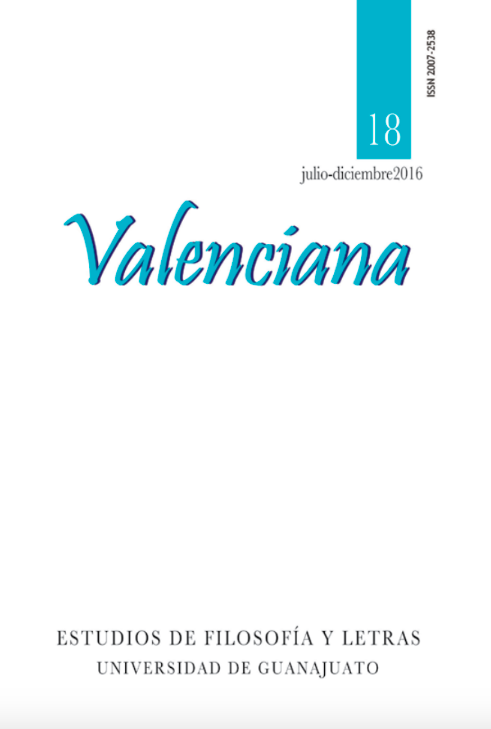The ethic and the aesthetic dimension of the trickster figure in literature
DOI:
https://doi.org/10.15174/rv.v0i18.160Abstract
The trickster figure is present in the mythologies, the folklore, and the literature of all over the world, from the most distant past to the modern day. The trickster embodies the freedom of the human spirit. It is a powerful and ambivalent figure: it has the ability to disturb the norm and introduce chaos as well as evil; but it can also reveal the truth and denounce social inequality. This paper analyzes the ethic-aesthetic dimension of the trickster in the field of literature, especially in Latin American literature, and it rehearses a tripartite provisional classification of this figure.References
Allende, Juan Rafael. Memorias de un perro escritas por su propia pata. Santiago de Chile: Imprenta de B. Vickuña Mackenna, 1893.
Auerbach, Eric. Figura. Prólogo de José María Cuesta Abad. Trad. Yolanda García y Julio Pardos. Madrid: Trotta, 1998.
Beltrán, Luis. Anatomía de la risa. México: Ediciones Sin Nombre-CONACYT-Universidad de Sonora, 2011.
------.La imaginación literaria. La seriedad y la risa en la literatura occidental. Madrid: Montesinos, 2002.
------. Simbolismo y Modernidad. Ed. Silvia Alicia Manzanilla Sosa. Yucatán: SEDECULTA, 2015.
Borges, Jorge Luis. Ficciones. El aleph. El informe de Brodie. Prólogo de Iraset Páez Urdaneta. Cronología y bibliografía de Horacio Jorge Becco. Caracas: Biblioteca Ayacucho, 1993, 1ª reimpresión.
Castro Rocha, João Cezar de. “Semnenhumcaráter? La rapsodia de Mário de Andrade”, en Macunaíma. El héroe sin ningún carácter. De Mário de Andrade. Trad. María Teresa Atrián Pineda. Cuba: Fondo Editorial Casa de las Américas, 2011.
Eliade, Mircea. La búsqueda: historia y sentido de las religiones. Trad. Alfonso Colodrón. Barcelona: Editorial Kairós, 1999.
Galvis, Silvia y Alberto Donadio. El jefe supremo: Rojas Pinilla en la violencia y en el poder. Colombia: Hombre Nuevo Editores, 2002, 2ª ed.
Harari, Yuval Noah. De animales a dioses. Breve historia de la humanidad. Trad. Joandomènec Ros. México: Debate, 2014.
Hesíodo.Teogonía. Introd. trad. y notas de Aurelio Pérez Jiménez y Alfonso Martínez Díez. Madrid: Gredos, 1978a. (Colección Biblioteca clásica Gredos.)
------. Trabajos y días. Introd. trad. y notas de Aurelio Pérez Jiménez y Alfonso Martínez Díez. Madrid: Gredos, 1978b. (Colección Biblioteca clásica Gredos.)
Idoyaga Molina, Anatilde. “Tiempo, espacio y existencia. Análisis de los seres míticos pilagá”, Revista de filología y lingüística 25.2 (1989): 39-50.
Lamadrid, Enrique R. “The Rogue´s Progress: Journeys of the Picaro from Oral Tradition to Contemporary Chicano Literature of New Mexico”, Melus 20.2 (1995): pp. 15-34.
Laval, Ramón A. Cuentos de Pedro Urdemales. (Trabajo leído en la Sociedad de Folklore chileno).Santigo de Chile: Imprenta Cervantes, 1925.
López Austin, Alfredo. Los mitos del tlacuache. Caminos de la mitología mesoamericana. México: UNAM, 2006.
Munguía Zatarain, Martha Elena. Elementos de poética histórica. El cuento hispanoamericano. México: El Colegio de México, 2002.
------. La risa en la literatura mexicana: apuntes de poética. México: Iberoamericana/Bonilla Artigas Editores, 2012a.
------. “De la hostilidad a la exaltación: valoraciones históricas de la risa. Resonancias éticas y estéticas”, en La risa: luces y sombras. Estudios disciplinarios. Coords. Claudia Gidi y Martha Elena Munguía Zatarain. Bonilla Artigas Editores; Universidad Veracruzana, 2012b, pp. 43-60.
Olivier, Guilhem. “Huehuecóyotl, “Coyote Viejo”, el músico transgresor: ¿Dios de los otomíes o avatar de Tezcatlipoca?”, Estudios de Cultura Náhuatl 30 (1999): 113-132. Disponible en red: http://www.ejournal.unam.mx/ecn/ecnahuatl30/ECN03005.pdf Última consulta: 17 de noviembre de 2015.
------. Tezcatlipoca. Burlas y metamorfosis de un dios azteca. Trad. Tatiana Sule. México: Fondo de Cultura Económica, 2004. (Colección Antropología.)
Pizarro, Jerónimo. “La `Carta prasicamiabas´: o la falta de carácter de un héroe imperial”, Revista do Instituto de Estudos Brasileiros 46 (2008): 179-199. Disponible en red: http://www.revistas.usp.br/rieb/article/viewFile/34604/37342[Última consulta: 18 de noviembre de 2015]
Radin, Paul. The Trickster. A Study in American Indian Mythology. Introducción Stanley Diamond. Nueva York: Philosophical Library, 1956.
Ricketts, Mac Linscott. “The North American Indian Trickster”, History of Religions 5.2 (1966): 327-350.
Robe, Stanley Linn. Mexican Tales and Legends from Los Altos. Berkeley: University of California Press, 1970.(Folklore Studies 20).
Romo Feito, Fernando. “La risa en Mijaíl Bajtín como hermenéutica”, en La risa: luces y sombras. Estudios disciplinarios. Coords. Claudia Gidi y Martha Elena Munguía. México: Bonilla Artigas Editores; Universidad Veracruzana, 2012, pp. 19-41.
Rulfo, Juan. Pedro Páramo y El llano en llamas. Planeta: México, 1992, 19ª impresión. (Colección popular.)
Samósata, Luciano de. Obras, vol 3. Trad. y notas de Juan Zaragoza Botella. Madrid: Gredos, 1990. (Biblioteca clásica Gredos 138.)
Uslar Pietri, Arturo. “Arturo Uslar Pietri habla su infancia”, Kalathos. Revista cultural 6 (junio-julio 2001): s.p. Entrevista realizada en Roma en 1978 por Enrique Hernández D´Jesús. Disponible en red: http://www.kalathos.com/jul2001/entrevistas/djesus/djesus.htm [Última consulta: 18 de noviembre de 2015]
Zuloaga, Conrado. Novelas del dictador, dictadores de novela. Bogotá: Carlos Valencia Ediciones, 1979.
Published
How to Cite
Issue
Section
License
Author(s) who publish in this journal do accept the next conditions:
According to copyright regulations, Valenciana does recognize and respect the authors’ moral right, as well as the right of property, which will be assigned to the journal for its diffusion in open access.
Valenciana does not charge authors for the submission, editorial process or publication in the journal.
All texts published and distributed by Valenciana (without exception) are supported by the license Creative Commons Attribution-NonCommercial 4.0 International (CC BY-NC 4.0), which allows third parties to use the publication as long as they mention the author and the first publication.
Authors can make other independent and additional contractual agreements for the non-exclusive use of his article published in Valenciana (e.g. including it in an institutional repository or in printed/electronic media), as long as it is explicitly clarified that the article was published for the first time in this journal.
For these purposes, authors must sign and send the letter of submission and copyright transfer form in a PDF file to this email address: revistavalenciana@gmail.com
This journal is under a license by Creative Commons Atribución-NoComercial-SinDerivadas 4.0 Internacional (CC BY-NC-ND 4.0)).











